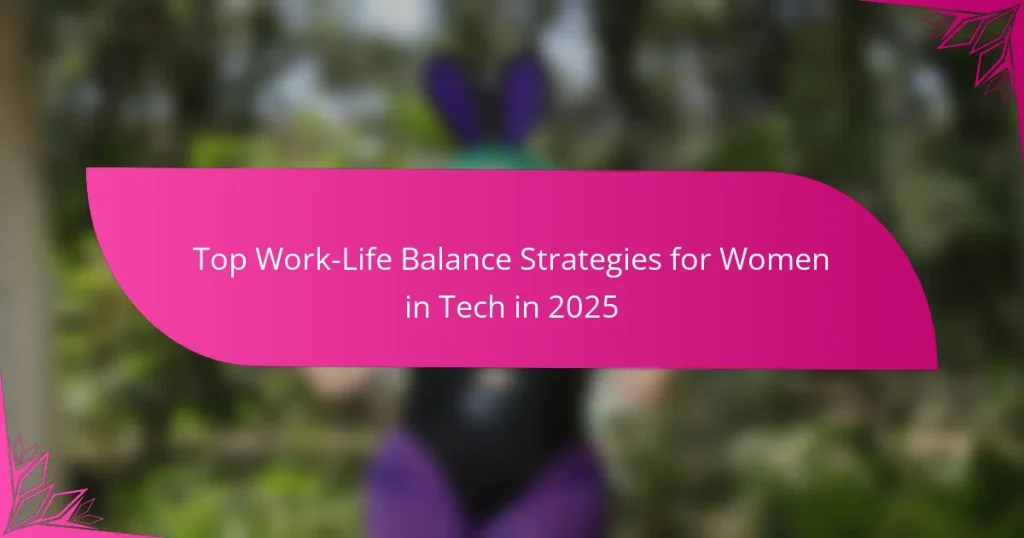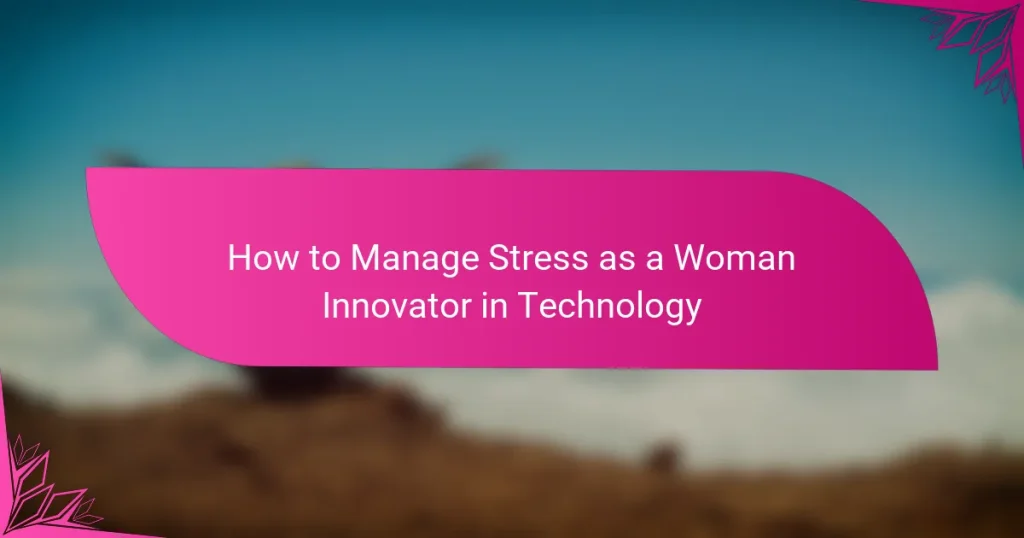Women innovators face unique challenges in achieving work-life balance, but effective strategies can help them thrive both professionally and personally. By embracing flexible work arrangements, leveraging technology, and seeking mentorship, they can create a harmonious blend of their responsibilities. These approaches not only enhance productivity but also prioritize personal well-being, allowing women to excel in their innovative pursuits.
Top Work-Life Balance Strategies for Women in Tech in 2025
The Importance of Mental Health Resources for Women in Technology
How to Manage Stress as a Woman Innovator in Technology
Comparing Flexible Work Arrangements for Women in Tech
Navigating Family Responsibilities While Advancing in Tech Careers
Creating a Supportive Work Environment for Women in Tech
What are effective work-life balance strategies for women innovators?
Effective work-life balance strategies for women innovators include flexible work hours, remote work opportunities, time management techniques, setting boundaries, and self-care practices. These approaches help manage professional responsibilities while maintaining personal well-being.
Flexible work hours
Flexible work hours allow women innovators to tailor their schedules to fit personal commitments, enhancing productivity and satisfaction. This might mean starting work earlier or later in the day, depending on family needs or personal preferences.
Employers can support this by offering core hours when everyone is expected to be available, while allowing flexibility outside of those times. This balance can lead to increased job satisfaction and retention rates.
Remote work opportunities
Remote work opportunities provide women innovators with the ability to work from home or other locations, reducing commute time and increasing flexibility. This arrangement can significantly enhance work-life balance by allowing for a more adaptable schedule.
Consider negotiating for hybrid work models that combine remote and in-office work, as this can offer the benefits of both environments. Many companies are increasingly recognizing the value of remote work in attracting and retaining talent.
Time management techniques
Implementing effective time management techniques is crucial for women innovators to maximize productivity. Techniques such as the Pomodoro Technique, where work is broken into intervals with short breaks, can help maintain focus and reduce burnout.
Creating a prioritized to-do list each day can also clarify tasks and deadlines, ensuring that important projects receive attention first. Utilizing digital tools like calendars and task management apps can further streamline this process.
Setting boundaries
Setting boundaries is essential for maintaining a healthy work-life balance. Women innovators should clearly define their work hours and communicate these to colleagues and family members to minimize interruptions during personal time.
It’s important to learn to say no to additional commitments that may overwhelm your schedule. Establishing these boundaries helps protect personal time and reduces stress, leading to better overall performance.
Self-care practices
Incorporating self-care practices into daily routines is vital for sustaining energy and motivation. Activities such as regular exercise, mindfulness meditation, and hobbies can significantly enhance mental and physical well-being.
Women innovators should prioritize self-care by scheduling time for these activities just as they would for work meetings. This commitment to personal health can lead to improved focus and creativity in professional endeavors.
How can women innovators leverage technology for work-life balance?
Women innovators can effectively leverage technology to enhance their work-life balance by utilizing various digital tools that streamline tasks, improve communication, and automate routine activities. By integrating these technologies into their daily routines, they can save time and reduce stress, allowing for a more harmonious blend of professional and personal responsibilities.
Productivity apps
Productivity apps are essential for managing tasks and time efficiently. Tools like Todoist, Trello, and Asana can help women innovators prioritize their work, set deadlines, and track progress. These apps often offer features like reminders and collaboration options, which can enhance focus and accountability.
When selecting a productivity app, consider your specific needs. For instance, if you prefer visual organization, Trello’s board system may suit you better than a traditional list format. Aim to choose one or two apps that integrate well with your existing tools to avoid overwhelming yourself with multiple platforms.
Collaboration tools
Collaboration tools facilitate seamless communication and teamwork, which is crucial for women innovators balancing various roles. Platforms like Slack, Microsoft Teams, and Zoom enable real-time discussions, file sharing, and video conferencing, making it easier to connect with colleagues and clients regardless of location.
To maximize the benefits of collaboration tools, establish clear guidelines for their use. For example, designate specific channels for different projects or topics to keep conversations organized. Regular check-ins can also help maintain team cohesion and ensure everyone is aligned on goals.
Virtual assistants
Virtual assistants, whether human or AI-based, can significantly reduce the burden of administrative tasks. Services like Upwork or platforms like Google Assistant can handle scheduling, reminders, and even research, freeing up valuable time for women innovators to focus on strategic initiatives.
When considering a virtual assistant, assess the tasks you find most time-consuming. Start with simple assignments, such as managing your calendar or organizing emails, and gradually increase their responsibilities as you become comfortable. This approach allows you to maintain control while benefiting from the support they provide.
What role does mentorship play in achieving work-life balance?
Mentorship plays a crucial role in helping women achieve work-life balance by providing guidance, support, and resources tailored to their unique challenges. A mentor can offer insights based on their experiences, helping mentees navigate career paths while managing personal responsibilities.
Access to guidance
Mentors provide valuable guidance that can help women prioritize their time and set realistic goals. This support can include advice on managing workloads, negotiating flexible hours, or finding efficient ways to balance professional and personal commitments. For instance, a mentor might suggest specific time management techniques that have worked for them.
Networking opportunities
Having a mentor often opens doors to networking opportunities that can enhance career prospects. Mentors can introduce mentees to influential contacts within their industry, facilitating connections that may lead to job opportunities or collaborations. Building a strong professional network is essential for women seeking to advance their careers while maintaining a healthy work-life balance.
Support systems
Mentorship fosters a support system that can be crucial during challenging times. A mentor can provide emotional support, encouragement, and practical advice when facing work-life balance dilemmas. This relationship can also help women feel less isolated in their struggles, knowing they have someone to turn to for understanding and assistance.
What are common challenges women innovators face in work-life balance?
Women innovators often encounter unique challenges in achieving work-life balance, including gender bias, societal expectations, and a lack of resources. These factors can hinder their professional growth and personal well-being, making it essential to address them effectively.
Gender bias in the workplace
Gender bias remains a significant barrier for women in innovation fields, affecting their opportunities for advancement and recognition. Women may face skepticism about their capabilities or be overlooked for leadership roles, which can lead to feelings of isolation and frustration.
To combat gender bias, women can seek mentorship and sponsorship from allies within their organizations. Building a strong professional network can help counteract biases and create more equitable environments.
Societal expectations
Societal expectations often place additional pressures on women to fulfill traditional roles, such as caregiving and household management. These expectations can create conflicts between personal and professional responsibilities, making it difficult to maintain a healthy work-life balance.
Women can address these challenges by setting clear boundaries and communicating their needs to family and colleagues. Prioritizing self-care and delegating tasks can also help alleviate the burden of societal expectations.
Lack of resources
Many women innovators face a lack of resources, including access to funding, professional development, and flexible work arrangements. This scarcity can limit their ability to pursue innovative ideas and maintain a sustainable work-life balance.
To overcome resource limitations, women should actively seek out grants, networking opportunities, and organizations that support female entrepreneurs. Utilizing online platforms and community resources can also provide valuable support and guidance.
How can organizations support women innovators in achieving balance?
Organizations can support women innovators by creating an environment that prioritizes work-life balance through flexible policies and resources. This includes implementing family-friendly practices that cater to the diverse needs of women in the workforce.
Implementing family-friendly policies
Family-friendly policies are essential for helping women innovators balance their professional and personal lives. These policies can include flexible working hours, remote work options, and parental leave that accommodates both mothers and fathers.
Organizations should consider offering on-site childcare services or partnerships with local childcare providers to ease the burden on working parents. Additionally, providing resources for mental health support can help women manage stress and maintain productivity.
To effectively implement these policies, organizations should actively seek feedback from employees to understand their needs. Regularly reviewing and updating these policies ensures they remain relevant and effective in supporting work-life balance.






